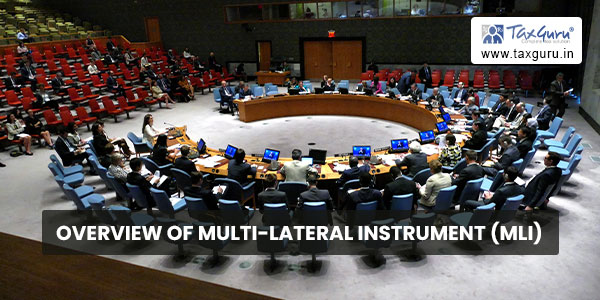Evolution of new business models, especially of the e-commerce kind have given businesses the opportunity to avoid tax by exploiting gaps and mismatches in the tax rules and artificially shift profits to low or no-tax jurisdictions, resulting in erosion of tax base in higher-tax jurisdictions, making it imperative for the governments to come up with a faster way of amending protocols to prevent tax evasion. The Organization for Economic Cooperation and Development (“OECD”) along with G20 Countries developed the Inclusive Framework on Base Erosion and Profit Shifting (“BEPS Project”) to curb tax avoidance.
A 15-point BEPS Action Plan was framed to tackle the problem of profit shifting and base erosion. Action Plan 15 coined the idea of developing a Multi-Lateral Instrument (MLI) to implement the BEPS measures, besides closing the gaps in existing international tax rules and improving the dispute resolution mechanisms, in existing Bilateral Tax Treaties, swiftly and efficiently, without the need to renegotiate each treaty separately. MLI was formally adopted in 2018, paving the way for facilitating modification of multiple treaties (3000+ treaties likely to be impacted) simultaneously, through a single instrument, which was indeed an unheard-of feat in legal history. 96 countries have signed the MLI of which 67 countries including India have ratified the same. Besides, 4 countries have now expressed their intent to sign the convention.

Procedure for adoption of MLI by the Signatories
Each Signatory should undertake steps to have the MLI ratified as per their domestic law, and thereafter deposit the instrument of ratification with the OECD depository. The Union Cabinet of India approved the ratification of MLI and deposited the ratified instrument with OECD on 25th June 2019, along with Reservations, Options and Notifications under the MLI. As a result, MLI entered into force from 1st October 2019 for India and will apply to bilateral treaties of India from FY 2020-21 onwards.
More about MLI
The MLI consists of 39 Articles categorized into 7 major parts namely:
1. Scope and Interpretation of Terms
2. Hybrid Mismatches
3. Treaty Abuse
4. Avoidance of Permanent Establishment Status
5. Improving Dispute Resolution
6. Arbitration
7. Final Provisions
MLI is a flexible instrument which will modify tax treaties according to a jurisdiction’s policy preferences in relation to implementation of BEPS measures. It can either introduce new provisions or replace or alter of existing provisions. However, signatories do not have the option to opt out of Action Plan 6 on Treaty Abuse and Action Plan 14 on Dispute Resolution, which are basically Minimum Standards prescribed. The Reservations deposited with the OECD Depository along with the ratified instrument will spell out the scope of applicability of the MLI Articles to each Treaty.
What is a Covered Tax Agreement (CTA)
In the context of MLI, we need to understand what “Covered Tax Agreement” is. In simple terms, existing bilateral tax treaties that is to be modified by MLI will be identified as a CTA. An existing bilateral tax treaty will qualify as a CTA when the following 4 conditions are fulfilled:
1. Both the countries to an existing treaty are signatories to MLI
2. Both the countries have ratified the MLI
3. Both the countries have deposited the ratified copies of MLI with the Depository
4. Both the countries, have, in the deposited copy, listed each other in their list of Tax Treaties to be modified by MLI.
India listed all its 93 Comprehensive DTAAs while depositing its ratified copy of MLI. Among all these bilateral treaties, only those tax treaties which fulfil all the above 4 conditions will qualify as CTAs, which will attract the articles of MLI. As on 1st April 2020, out of 93 treaties listed by India in its ratified MLI deposited, 23 countries have listed treaty with India in their deposited ratified copies of MLI. The DTAAs with these countries will be modified by MLI.
Conclusion
Modification of tax treaties through MLI hopes to curb revenue loss through treaty abuse, base erosion and profit shifting strategies. It also aims at ensuring that profits are taxed where substantive economic activities generating the profits are carried out.
While the MLI will be applied alongside existing tax treaties, modifying their application in order to implement the BEPS measures, it is to be seen how effective this innovative piece of legislation would be in achieving the new purpose which is now included in the preamble to every CTA:
“Intending to eliminate double taxation with respect to the taxes covered by this agreement without creating opportunities for non-taxation or reduced taxation through tax evasion or avoidance (including through treaty-shopping arrangements aimed at obtaining reliefs provided in this agreement for the indirect benefit of residents of third jurisdictions)”





A very good article. Explains the introduction of MLI in the simplest possible way.I appreciate it.